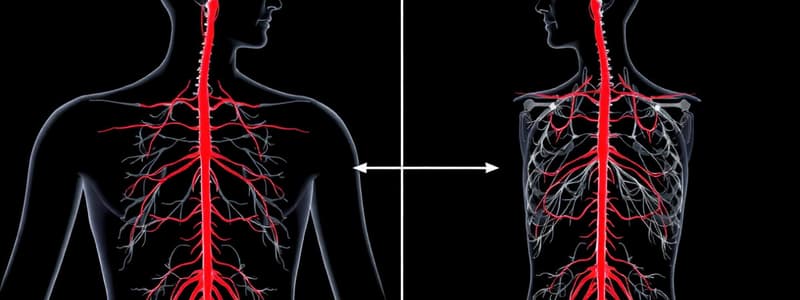Podcast
Questions and Answers
What effect do muscarinic (M1) receptors have on the stomach?
What effect do muscarinic (M1) receptors have on the stomach?
- Enhance mucus production
- Reduce stomach motility
- Decrease HCl secretion
- Increase HCl secretion (correct)
Which of the following statements about Muscarinic (M2) receptors is true?
Which of the following statements about Muscarinic (M2) receptors is true?
- They decrease heart rate. (correct)
- They have no effect on heart conductivity.
- They enhance atrial contraction.
- They increase the heart rate.
Which negative effect is associated with Muscarinic (M2) receptor stimulation?
Which negative effect is associated with Muscarinic (M2) receptor stimulation?
- Increased heart rate
- Enhanced conductivity
- Increased atrial contraction
- Negative dromotropy (correct)
What is the primary transmitter that muscarinic receptors respond to?
What is the primary transmitter that muscarinic receptors respond to?
Which enzymes are responsible for the hydrolysis of acetylcholine?
Which enzymes are responsible for the hydrolysis of acetylcholine?
What are the characteristics of the preganglionic fibers in the parasympathetic nervous system?
What are the characteristics of the preganglionic fibers in the parasympathetic nervous system?
Which neurotransmitter is primarily released by postganglionic axons in the sympathetic nervous system?
Which neurotransmitter is primarily released by postganglionic axons in the sympathetic nervous system?
What is the typical length of postganglionic fibers in the parasympathetic nervous system?
What is the typical length of postganglionic fibers in the parasympathetic nervous system?
What receptors are found in the parasympathetic nervous system that stimulate all autonomic ganglia?
What receptors are found in the parasympathetic nervous system that stimulate all autonomic ganglia?
Which division of the autonomic nervous system is also referred to as the craniosacral division?
Which division of the autonomic nervous system is also referred to as the craniosacral division?
Flashcards are hidden until you start studying
Study Notes
Autonomic Nervous System
- The Autonomic Nervous System (ANS) is divided into the Sympathetic and Parasympathetic Nervous Systems
- The Sympathetic Nervous System is responsible for the 'fight or flight' response
- The Parasympathetic Nervous System is responsible for the 'rest and digest' response.
- The ANS is also called the visceral motor system and controls involuntary bodily functions.
Anatomical Differences between Sympathetic and Parasympathetic Divisions
- Sympathetic preganglionic fibers are short and postganglionic fibers are long.
- Parasympathetic preganglionic fibers are long and postganglionic fibers are short.
Functional Differences between Sympathetic and Parasympathetic Nervous Systems
- The Sympathetic Nervous System mainly releases norepinephrine from postganglionic axons
- The Parasympathetic Nervous System mainly releases acetylcholine from postganglionic axons
- Both Sympathetic and Parasympathetic preganglionic axons release acetylcholine
- Acetylcholine is a naturally occurring neurotransmitter rapidly hydrolyzed by neuronal acetylcholinesterase and plasma butyrylcholinesterase.
Receptors involved in Parasympathetic Nervous System
- There are two types of cholinergic receptors: Nicotinic and Muscarinic
- Nicotinic receptors (N1 or NN) are located on all autonomic ganglia and mediate the release of norepinephrine and epinephrine from the adrenal gland
- Nicotinic receptors (N2 or NM) are located on skeletal muscle and mediate skeletal muscle contraction
- Muscarinic receptors (M) are located on all effector cells stimulated by postganglionic cholinergic fibers
- Muscarinic (M1) receptors are located in the stomach and increase HCl secretion
- Muscarinic (M2) receptors are located in the heart and decrease heart rate, conduction velocity, and force of contraction
- Muscarinic (M3) receptors are located in blood vessels and cause vasodilation due to release of nitric oxide (NO)
- Muscarinic (M3) receptors are also located in the eye and cause miosis, reduction in intraocular pressure (IOP) and accommodation to near vision
- Muscarinic (M3) receptors are located in the respiratory tract and cause bronchoconstriction and increased bronchial secretion
- Muscarinic (M3) receptors are located in the exocrine glands and cause increased secretion of saliva, sweat, and tears
- Muscarinic (M3) receptors are located in the urinary bladder and cause contraction of the bladder wall and relaxation of the ureter and sphincters
- Muscarinic (M3) receptors are located in the intestine and cause increased motility and secretion and relaxation of sphincters
Parasympathetic Nervous system Key Roles
- Parasympathetic postganglionic neurons release acetylcholine. They are located in the autonomic ganglia, adrenal medulla, and skeletal muscles.
- They play a role in regulating heart rate, blood pressure, digestion, and other bodily functions.
Key Parasympathetic Functions
- Decrease heart rate
- Slow heart conduction
- Decrease atrial contraction
- Vasodilation
- Miosis (pupil constriction).
- Reduction in Intraocular Pressure (IOP).
- Accommodation to near vision.
- Bronchoconstriction.
- Increase bronchial secretion.
- Increase salivary, lacrimal (tear) and sweat gland secretion..
- Increase gastrointestinal motility and secretion..
- Increase bladder contraction.
- Relaxation of urethral sphincter.
- Erection of penis and clitoris .
Studying That Suits You
Use AI to generate personalized quizzes and flashcards to suit your learning preferences.




